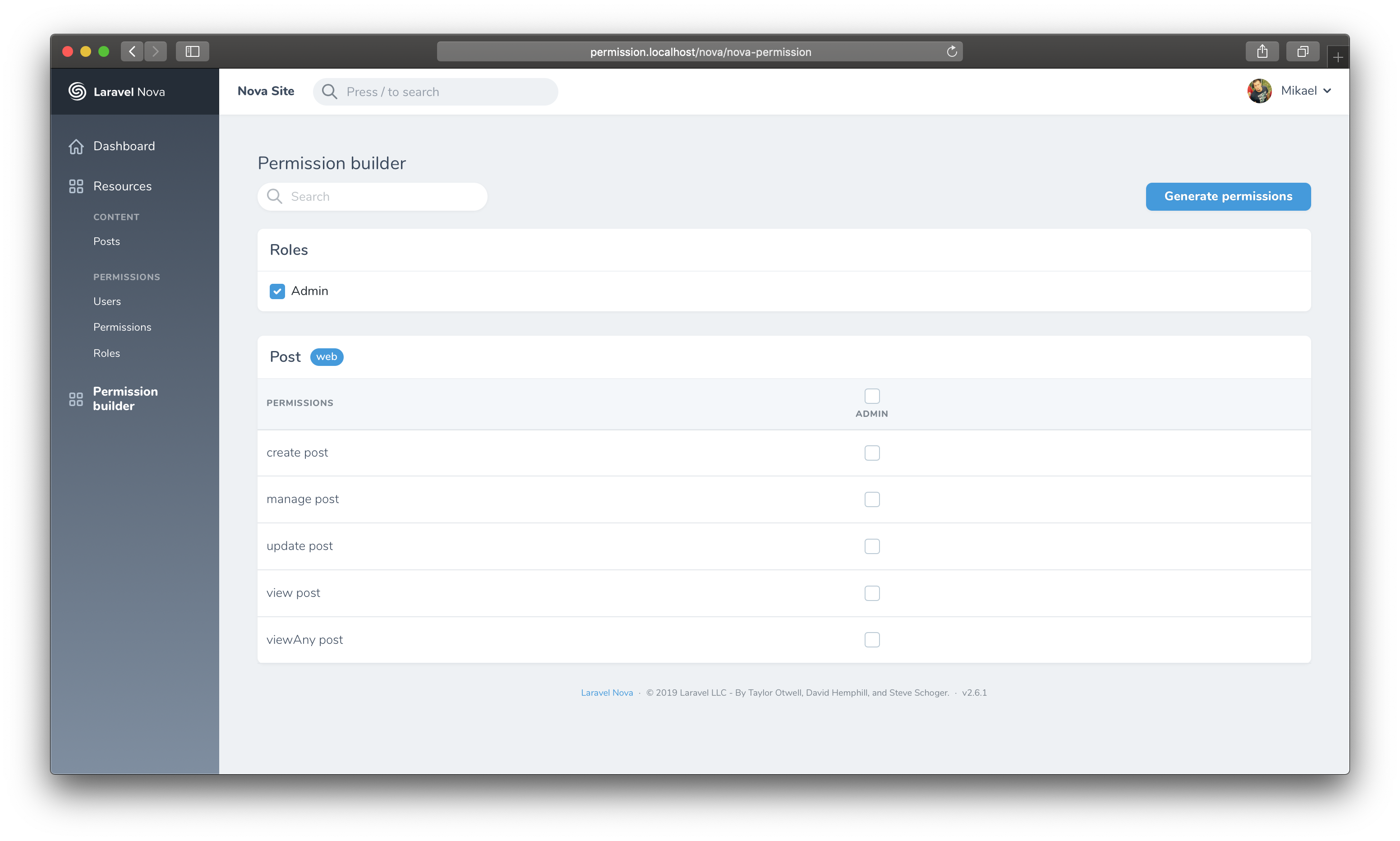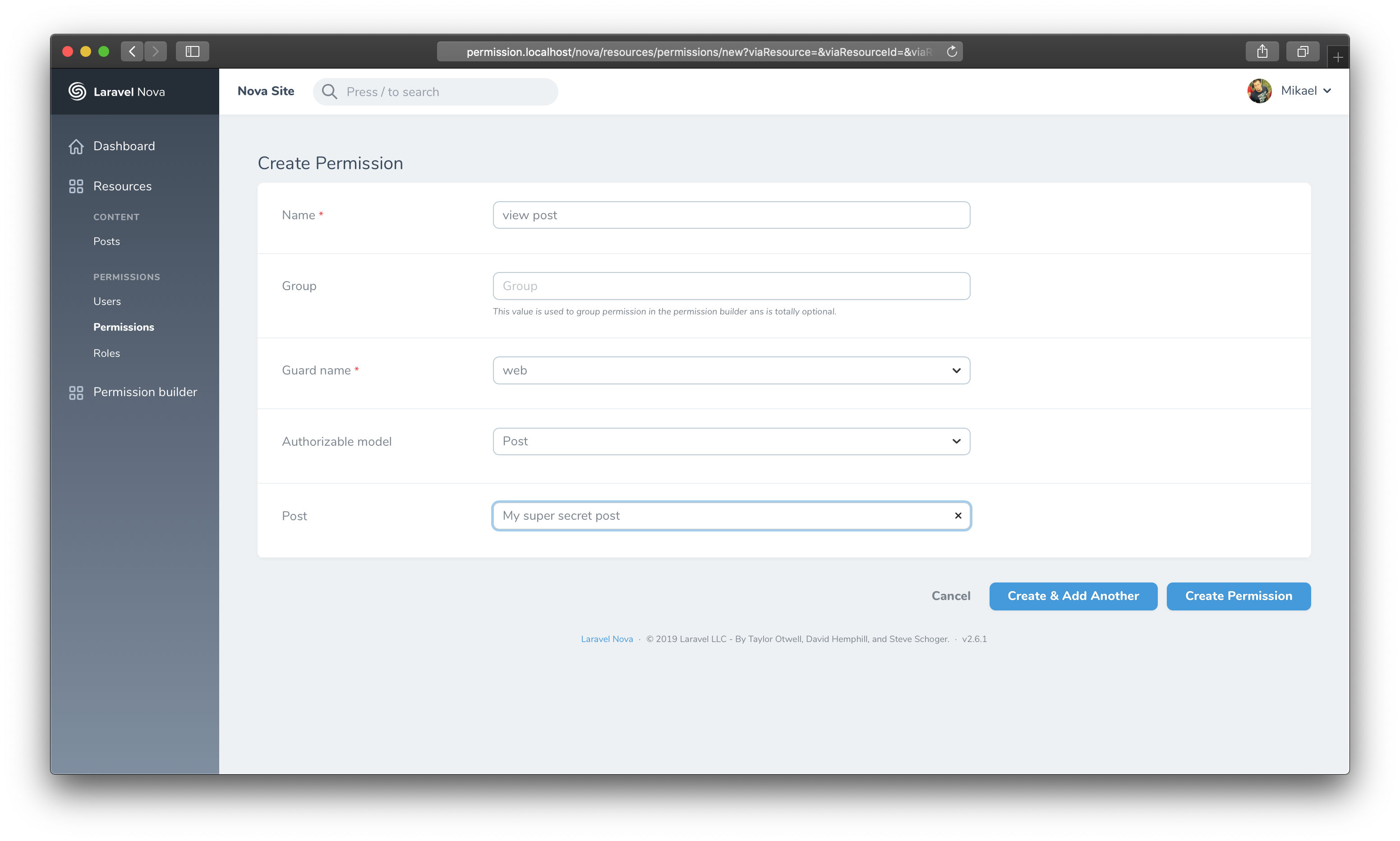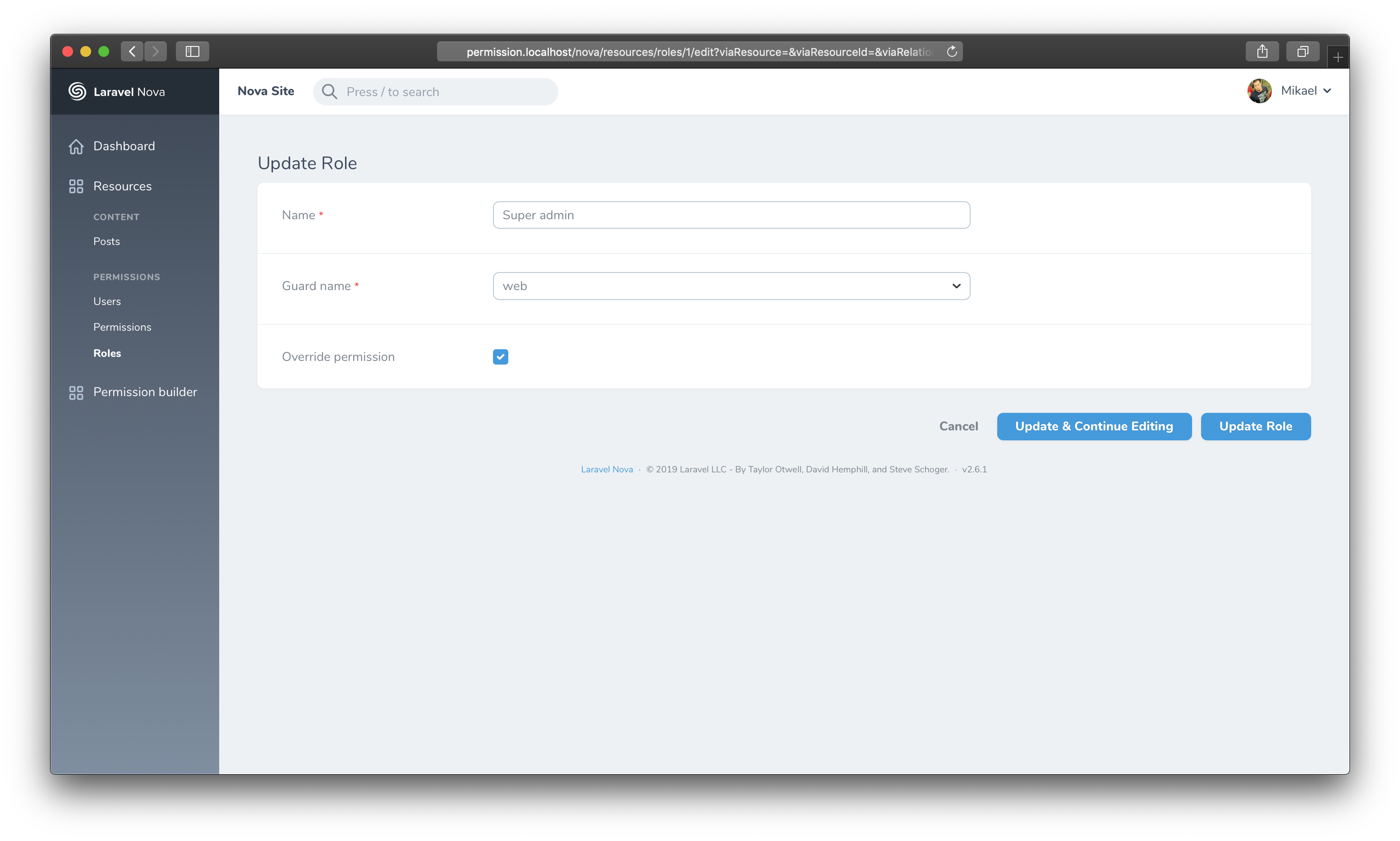Based on spatie/permission, this tool gives you ability to manage roles and permission. The tool provides permission builder.
You can install the nova tool in to a Laravel app that uses Nova via composer:
composer require bbs-lab/nova-permissionThe service provider will automatically get registered. Or you may manually add the service provider in your config/app.php file:
'providers' => [
// ...
BBSLab\NovaPermission\NovaPermissionServiceProvider::class,
],You should publish the migrations with:
php artisan vendor:publish --provider="Spatie\Permission\PermissionServiceProvider" --tag="migrations"
php artisan vendor:publish --provider="BBSLab\NovaPermission\NovaPermissionServiceProvider" --tag="migrations"You can publish the config files with:
php artisan vendor:publish --provider="BBSLab\NovaPermission\NovaPermissionServiceProvider" --tag="config"This will publish config/permission.php and config/nova-permission.php files with the following contents:
// config/permission.php
return [
'models' => [
/*
* When using the "HasPermissions" trait from this package, we need to know which
* Eloquent model should be used to retrieve your permissions. Of course, it
* is often just the "Permission" model but you may use whatever you like.
*
* The model you want to use as a Permission model needs to implement the
* `BBSLab\NovaPermission\Contracts\Permission` contract.
*/
'permission' => BBSLab\NovaPermission\Models\Permission::class,
/*
* When using the "HasRoles" trait from this package, we need to know which
* Eloquent model should be used to retrieve your roles. Of course, it
* is often just the "Role" model but you may use whatever you like.
*
* The model you want to use as a Role model needs to implement the
* `BBSLab\NovaPermission\Contracts\Role` contract.
*/
'role' => BBSLab\NovaPermission\Models\Role::class,
],
'table_names' => [
/*
* When using the "HasRoles" trait from this package, we need to know which
* table should be used to retrieve your roles. We have chosen a basic
* default value but you may easily change it to any table you like.
*/
'roles' => 'roles',
/*
* When using the "HasPermissions" trait from this package, we need to know which
* table should be used to retrieve your permissions. We have chosen a basic
* default value but you may easily change it to any table you like.
*/
'permissions' => 'permissions',
/*
* When using the "HasPermissions" trait from this package, we need to know which
* table should be used to retrieve your models permissions. We have chosen a
* basic default value but you may easily change it to any table you like.
*/
'model_has_permissions' => 'model_has_permissions',
/*
* When using the "HasRoles" trait from this package, we need to know which
* table should be used to retrieve your models roles. We have chosen a
* basic default value but you may easily change it to any table you like.
*/
'model_has_roles' => 'model_has_roles',
/*
* When using the "HasRoles" trait from this package, we need to know which
* table should be used to retrieve your roles permissions. We have chosen a
* basic default value but you may easily change it to any table you like.
*/
'role_has_permissions' => 'role_has_permissions',
],
'column_names' => [
/*
* Change this if you want to name the related model primary key other than
* `model_id`.
*
* For example, this would be nice if your primary keys are all UUIDs. In
* that case, name this `model_uuid`.
*/
'model_morph_key' => 'model_id',
],
/*
* When set to true, the required permission/role names are added to the exception
* message. This could be considered an information leak in some contexts, so
* the default setting is false here for optimum safety.
*/
'display_permission_in_exception' => false,
'cache' => [
/*
* By default all permissions are cached for 24 hours to speed up performance.
* When permissions or roles are updated the cache is flushed automatically.
*/
'expiration_time' => \DateInterval::createFromDateString('24 hours'),
/*
* The cache key used to store all permissions.
*/
'key' => 'spatie.permission.cache',
/*
* When checking for a permission against a model by passing a Permission
* instance to the check, this key determines what attribute on the
* Permissions model is used to cache against.
*
* Ideally, this should match your preferred way of checking permissions, eg:
* `$user->can('view-posts')` would be 'name'.
*/
'model_key' => 'name',
/*
* You may optionally indicate a specific cache driver to use for permission and
* role caching using any of the `store` drivers listed in the cache.php config
* file. Using 'default' here means to use the `default` set in cache.php.
*/
'store' => 'default',
],
];// config/nova-permission
return [
'authorizable_models' => [
// \App\Models\Post::class,
],
'generate_without_resources' => [
\Laravel\Nova\Actions\ActionResource::class,
\BBSLab\NovaPermission\Resources\Role::class,
\BBSLab\NovaPermission\Resources\Permission::class,
]
];After the migration has been published you can create the role- and permission-tables by running the migrations:
php artisan migrateYou must register the tool with Nova. This is typically done in the tools method of the NovaServiceProvider:
// app/Providers/NovaServiceProvider.php
public function tools()
{
return [
// ...
new BBSLab\NovaPermission\PermissionBuilder(),
];
}The tool allow to generate resource permissions. Your resource must implement BBSLab\NovaPermission\Contracts\HasAbilities and define the public static $permissionsForAbilities variable:
namespace App\Nova;
use BBSLab\NovaPermission\Contracts\HasAbilities;
use BBSLab\NovaPermission\Traits\Authorizable;
class Post extends Resource implements HasAbilities
{
use Authorizable;
public static $permissionsForAbilities = [
'create' => 'create post',
];
}This configuration will generate the following permission:
[
'name' => 'create post',
'group' => 'Post',
'guard_name' => 'web', // the nova guard or default auth guard
]You may generate permission from the permission builder tool with the Generate permissions button or the Artisan command:
php artisan nova-permission:generateYou can use Laravel policies as usual:
namespace App\Policies;
use App\User;
use App\Post;
use Illuminate\Auth\Access\HandlesAuthorization;
class PostPolicy
{
use HandlesAuthorization;
/**
* Determine whether the user can view any post.
*
* @param \App\User $user
* @return mixed
*/
public function viewAny(User $user)
{
if ($user->hasPermissionTo('viewAny post')) {
return true;
}
}
/**
* Determine whether the user can update the post.
*
* @param \App\User $user
* @param \App\Post $post
* @return mixed
*/
public function update(User $user, Post $post)
{
if ($user->hasPermissionTo('update post')) {
return true;
}
}
}Sometimes you may want to protect a particular resource. First the model must implement the BBSLab\NovaPermission\Contracts\HasAuthorizations:
namespace App\Models;
use BBSLab\NovaPermission\Contracts\HasAuthorizations;
use BBSLab\NovaPermission\Traits\Authorizations;
class Post extends Model implements HasAuthorizations
{
use Authorizations;
}You need to add the resource in the config/nova-permission.php:
'authorizable_models' => [
\App\Nova\Post::class,
],You can now create a permission attached on to a specific post:
And update the post policy:
/**
* Determine whether the user can update the post.
*
* @param \App\User $user
* @param \App\Post $post
* @return mixed
*/
public function update(User $user, Post $post)
{
if ($user->hasPermissionToOnModel('update post', $post)) {
return true;
}
}You may want to create role as super admin. You can do that using the override_permission attribute.
You may prevent override_permission attribute modification by using the BBSLab\NovaPermission\Resources\Role::canSeeOverridePermmission method:
// in a service provider
BBSLab\NovaPermission\Resources\Role::canSeeOverridePermmission(function (Request $request) {
// implement your logic
});Please see CHANGELOG for more information what has changed recently.
If you discover any security related issues, please email [email protected] instead of using the issue tracker.
Please see CONTRIBUTING for details.
The MIT License (MIT). Please see License File for more information.






